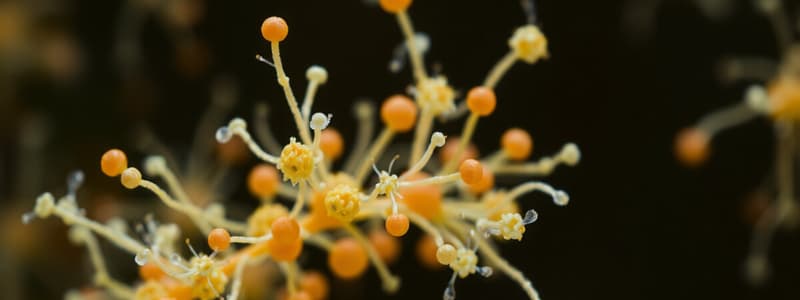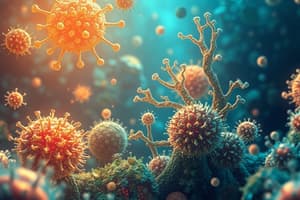Podcast
Questions and Answers
What is the minimum water activity (aw) at which Clostridium perfringens can replicate using glycerol as a solute?
What is the minimum water activity (aw) at which Clostridium perfringens can replicate using glycerol as a solute?
- 0.97
- 0.90
- 0.93 (correct)
- 0.95
Which solute is most inhibitory to growth at a water activity of 0.97?
Which solute is most inhibitory to growth at a water activity of 0.97?
- Sucrose
- Glucose
- Salt (correct)
- Glycerol
What aw value can be achieved using a 22% aqueous solution of glycerol?
What aw value can be achieved using a 22% aqueous solution of glycerol?
- 0.90
- 0.97
- 0.92
- 0.95 (correct)
What is the primary focus of food microbial ecology?
What is the primary focus of food microbial ecology?
Which of the following correctly defines a microbial community?
Which of the following correctly defines a microbial community?
Which of the following factors is NOT typically affected by the choice of solute in food formulations?
Which of the following factors is NOT typically affected by the choice of solute in food formulations?
What are intrinsic factors affecting microbial growth in food?
What are intrinsic factors affecting microbial growth in food?
How do microorganisms impact food quality during their life cycle?
How do microorganisms impact food quality during their life cycle?
What is the approximate aw value achieved by a sodium chloride (NaCl) solution at 25°C?
What is the approximate aw value achieved by a sodium chloride (NaCl) solution at 25°C?
What role does microbial food ecology play in food processing?
What role does microbial food ecology play in food processing?
Which sugar requires the least concentration to achieve an aw of 0.90?
Which sugar requires the least concentration to achieve an aw of 0.90?
In which habitat would you find a specific microbial population?
In which habitat would you find a specific microbial population?
Which statement best describes the niche in microbial ecology?
Which statement best describes the niche in microbial ecology?
What is one of the key roles of food microbiology?
What is one of the key roles of food microbiology?
Which compound serves as a compatible solute in Staphylococcus?
Which compound serves as a compatible solute in Staphylococcus?
What is a key characteristic of glycine betaine?
What is a key characteristic of glycine betaine?
In organisms growing in low water activity conditions, how can they acquire water?
In organisms growing in low water activity conditions, how can they acquire water?
What type of solutes must be used to avoid inhibiting cellular processes?
What type of solutes must be used to avoid inhibiting cellular processes?
Which of the following is classified as a compatible solute for extreme halophilic Archaea?
Which of the following is classified as a compatible solute for extreme halophilic Archaea?
What is an example of a compatible solute utilized by xerophilic yeasts and molds?
What is an example of a compatible solute utilized by xerophilic yeasts and molds?
What property of compatible solutes allows them to stabilize proteins and membranes?
What property of compatible solutes allows them to stabilize proteins and membranes?
Which groups of microorganisms are known to use organic solutes or ions to regulate water activity within cells?
Which groups of microorganisms are known to use organic solutes or ions to regulate water activity within cells?
Which of the following best describes intrinsic factors affecting microbial growth?
Which of the following best describes intrinsic factors affecting microbial growth?
What is the primary role of water activity in microbial growth?
What is the primary role of water activity in microbial growth?
How does increasing solute concentration in food affect microbial growth?
How does increasing solute concentration in food affect microbial growth?
What characteristic of bound water differentiates it from free water?
What characteristic of bound water differentiates it from free water?
Which of the following statements is true regarding weakly incorporated water in macrostructures?
Which of the following statements is true regarding weakly incorporated water in macrostructures?
Which microorganism is capable of growing at extremely low water activity (aw) values of 0.75 or lower?
Which microorganism is capable of growing at extremely low water activity (aw) values of 0.75 or lower?
How does crystallization during freezing affect microbial development?
How does crystallization during freezing affect microbial development?
What distinguishes halophiles from halotolerant microorganisms?
What distinguishes halophiles from halotolerant microorganisms?
Which microorganism is an example of an osmophile?
Which microorganism is an example of an osmophile?
What effect does the presence of hydrophilic colloids, like agar, have on water availability?
What effect does the presence of hydrophilic colloids, like agar, have on water availability?
Which statement about redox potential is accurate concerning food preservation?
Which statement about redox potential is accurate concerning food preservation?
At what water activity level is E. coli sensitive to salt concentration?
At what water activity level is E. coli sensitive to salt concentration?
Which of the following is an example of a moderate halophile?
Which of the following is an example of a moderate halophile?
What effect does increased salt concentration have on water activity (aw)?
What effect does increased salt concentration have on water activity (aw)?
Which type of microorganism can tolerate high salt concentrations but prefers lower ones?
Which type of microorganism can tolerate high salt concentrations but prefers lower ones?
What is one outcome of the toxic effect of salt on microorganisms?
What is one outcome of the toxic effect of salt on microorganisms?
What is the general order of sensitivity of microorganisms to decreasing water activity (aw)?
What is the general order of sensitivity of microorganisms to decreasing water activity (aw)?
At what minimum water activity (aw) can Staphylococcus aureus grow?
At what minimum water activity (aw) can Staphylococcus aureus grow?
What happens to microorganisms as the water activity (aw) decreases?
What happens to microorganisms as the water activity (aw) decreases?
How does Staphylococcus aureus's ability to survive at low aw impact its toxin production?
How does Staphylococcus aureus's ability to survive at low aw impact its toxin production?
What is the typical range of water activity (aw) within which microbial growth occurs?
What is the typical range of water activity (aw) within which microbial growth occurs?
Which of the following best describes the relationship between reduced water activity (aw) and thermal stress on microorganisms?
Which of the following best describes the relationship between reduced water activity (aw) and thermal stress on microorganisms?
What factors affect the range of water activity (aw) that microorganisms can tolerate?
What factors affect the range of water activity (aw) that microorganisms can tolerate?
What term did Prof. Leistner use to describe a method of ensuring microbial safety in food products?
What term did Prof. Leistner use to describe a method of ensuring microbial safety in food products?
Flashcards
What are intrinsic factors?
What are intrinsic factors?
Intrinsic factors are related to the food itself - its composition and structure. They affect microbial growth by interacting with each other.
What is water activity?
What is water activity?
Water activity represents the fraction of water available for microbial growth and degradation.
What is bound water?
What is bound water?
Bound water is tightly linked to food components like proteins, sugars, and salts, making it unavailable for microbial growth.
What is free water?
What is free water?
Signup and view all the flashcards
How do solutes influence microbial growth?
How do solutes influence microbial growth?
Signup and view all the flashcards
How do hydrophilic colloids affect microbial growth?
How do hydrophilic colloids affect microbial growth?
Signup and view all the flashcards
How does freezing affect microbial growth?
How does freezing affect microbial growth?
Signup and view all the flashcards
How does water activity differ from moisture content?
How does water activity differ from moisture content?
Signup and view all the flashcards
Food microbial ecology
Food microbial ecology
Signup and view all the flashcards
Microbial population
Microbial population
Signup and view all the flashcards
Microbial community
Microbial community
Signup and view all the flashcards
Habitat
Habitat
Signup and view all the flashcards
Niche
Niche
Signup and view all the flashcards
Food spoilage
Food spoilage
Signup and view all the flashcards
Intrinsic factors
Intrinsic factors
Signup and view all the flashcards
Ecophysiology of MOs in food
Ecophysiology of MOs in food
Signup and view all the flashcards
Water activity (aw)
Water activity (aw)
Signup and view all the flashcards
Growth range (aw)
Growth range (aw)
Signup and view all the flashcards
Minimum aw for growth
Minimum aw for growth
Signup and view all the flashcards
Optimal aw for growth
Optimal aw for growth
Signup and view all the flashcards
Order of sensitivity to decreasing aw
Order of sensitivity to decreasing aw
Signup and view all the flashcards
Gram-negative bacteria
Gram-negative bacteria
Signup and view all the flashcards
Gram-positive bacteria
Gram-positive bacteria
Signup and view all the flashcards
Duplication phase
Duplication phase
Signup and view all the flashcards
Low water activity
Low water activity
Signup and view all the flashcards
Compatible solutes
Compatible solutes
Signup and view all the flashcards
Glycine betaine
Glycine betaine
Signup and view all the flashcards
Ectoine
Ectoine
Signup and view all the flashcards
Glycerol
Glycerol
Signup and view all the flashcards
Proline
Proline
Signup and view all the flashcards
Uptake of inorganic ions
Uptake of inorganic ions
Signup and view all the flashcards
Synthesis or concentration of organic solutes
Synthesis or concentration of organic solutes
Signup and view all the flashcards
Xerophiles
Xerophiles
Signup and view all the flashcards
Halophiles
Halophiles
Signup and view all the flashcards
Halotolerant
Halotolerant
Signup and view all the flashcards
Osmophiles
Osmophiles
Signup and view all the flashcards
Salt and Microorganism Growth
Salt and Microorganism Growth
Signup and view all the flashcards
Salt Concentration and aw
Salt Concentration and aw
Signup and view all the flashcards
Extreme Halophiles in Food
Extreme Halophiles in Food
Signup and view all the flashcards
What is water activity (aw)?
What is water activity (aw)?
Signup and view all the flashcards
How does water activity (aw) impact microbial growth?
How does water activity (aw) impact microbial growth?
Signup and view all the flashcards
How do salt and sugar affect water activity (aw)?
How do salt and sugar affect water activity (aw)?
Signup and view all the flashcards
How does glycerol affect water activity (aw)?
How does glycerol affect water activity (aw)?
Signup and view all the flashcards
How do different types of sugars affect aw?
How do different types of sugars affect aw?
Signup and view all the flashcards
What is the freezing point depression factor (FPDF)?
What is the freezing point depression factor (FPDF)?
Signup and view all the flashcards
What other food components affect water activity (aw)?
What other food components affect water activity (aw)?
Signup and view all the flashcards
Study Notes
Food Microbial Ecology
- Food microbial ecology studies the interactions between food characteristics (chemical, physical, and structural) and its microbial population.
- Habitat describes the surrounding environment's abiotic characteristics.
- Microbial population refers to groups of similar individuals (cells) within a specific area.
- Microbial community represents the populations together in a habitat, including their interactions and functions.
- Niche is a biological community with unique metabolic activity that develops within a specific habitat.
Summary
- Factors impacting microbial growth within food were discussed.
- The ecophysiology of microorganisms in food was examined.
- Intrinsic factors, such as pH and water activity (aw), and redox potential, are crucial for microbial growth in food.
What Does Food Microbial Ecology Study?
- Food microorganisms can cause quality deterioration and safety issues.
- Microorganisms interact with food substrate (or raw materials).
- Contamination during processing and consumption can affect microorganisms.
- Microbial growth does not always mean negative results in food, but its effect can negatively impact food quality.
Microorganisms in Food
- The study of microorganisms' impact on food is essential.
Intrinsic Factors of Food
- pH
- Water activity (aw)
- Redox potential (Eh)
- Food components
- Added antimicrobial substances
Water Activity (aw)
- The ratio of vapor pressure of a food to the pure water vapor pressure.
- Water activity is essential for microorganisms because it defines water availability for biological functions.
- Lower aw values correlate with decreased microbial growth, thus influencing food safety and stability.
Growth at Low aw
- The growth rate of microorganisms is significantly reduced at low water activities.
- Microorganisms adapt to low water activity by adjusting and accumulating compatible solutes.
- Microorganisms may develop strategies for survival at low water activity.
Water Activity and Classification
- Different microorganisms show different sensitivities to varying water activities and their optimal and minimum water activities.
- Xerophiles, halophiles, and osmophiles are examples of organisms adapted to specific water activity conditions.
- Water activity (aw) values relate to microbial survival.
Salt and Water Activity
- Salt and water concentrations can influence water activity (aw).
- Increasing salt concentration will lead to decreased water activity, thus impacting microbial growth in a food system.
Salt vs. Glucose and Water Activity
- Various concentrations of sodium chloride (NaCl) and glucose affect the water activity (aw) of solutions.
- Glycerol is a common substance used to lower water activity in various food products.
Moisture and Water Activity
- The difference between total water and available water.
- Different foods have different water contents and this correlates to the different water retention capacities of these foods.
- Lower water activity (aw) values in foods can reduce microbial growth.
Water Content Critical Limit (aw 0.70)
- Foods with an aw below 0.70 are generally stable and can be stored for extended periods.
- Moisture content values for products such as nuts, dried pasta, honey, and powdered milk.
- These foods do not spoil if they are stored properly.
Studying That Suits You
Use AI to generate personalized quizzes and flashcards to suit your learning preferences.




